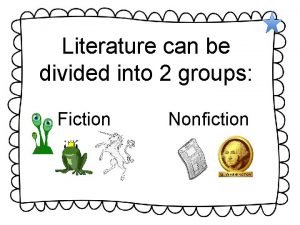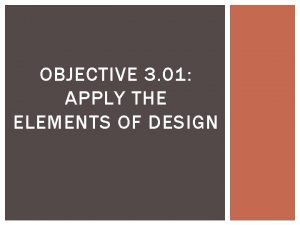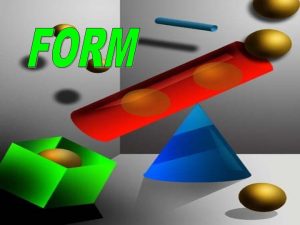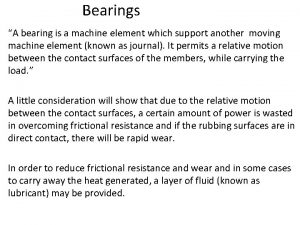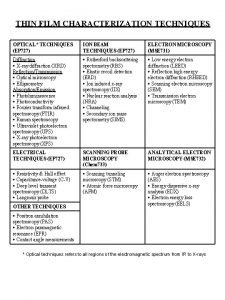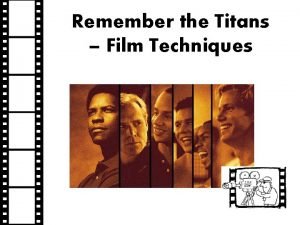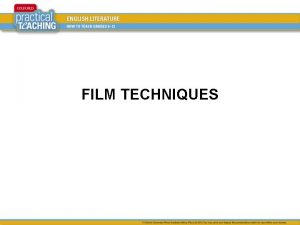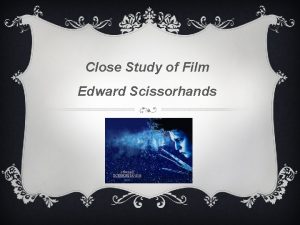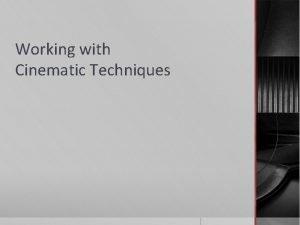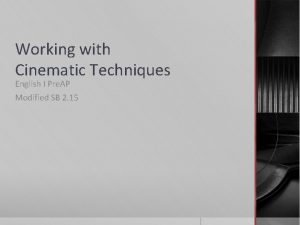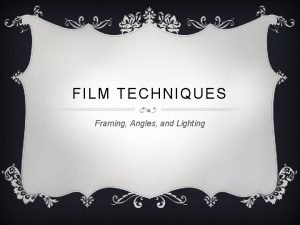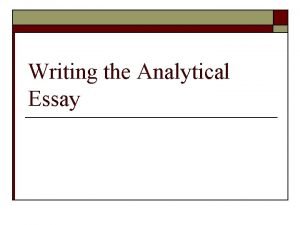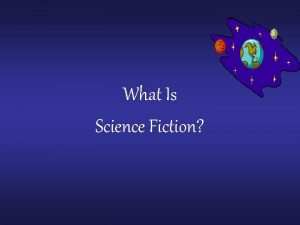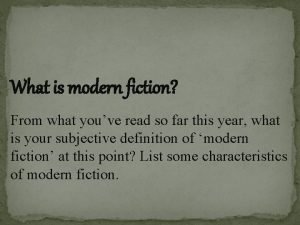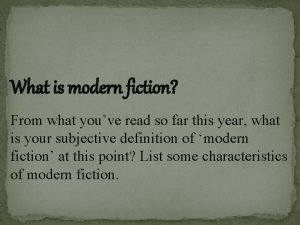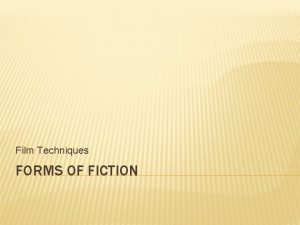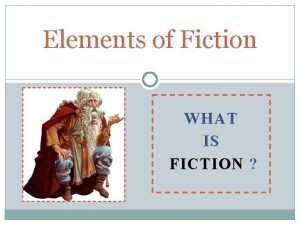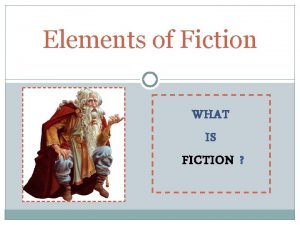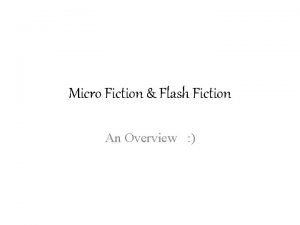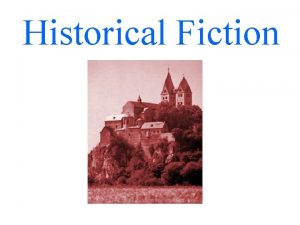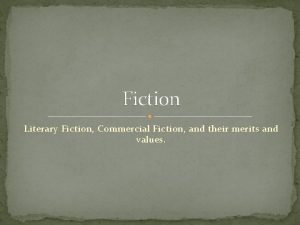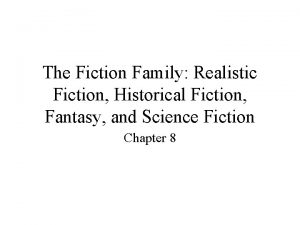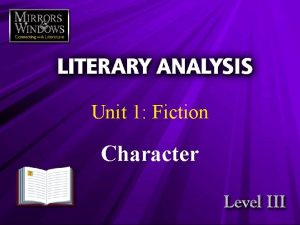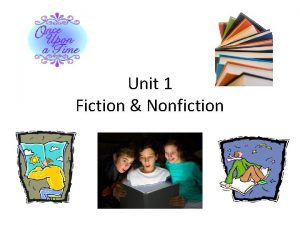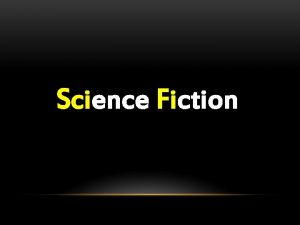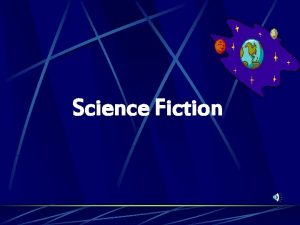Film Techniques FORMS OF FICTION FILM TECHNIQUES Film
























- Slides: 24

Film Techniques FORMS OF FICTION

FILM TECHNIQUES � Film techniques describe the way meaning is created in film.

CAMERA SHOTS �A camera shot is the amount of space that is seen in one shot or frame. Camera shots are used to demonstrate different aspects of a film's setting, characters and themes. As a result, camera shots are very important in shaping meaning in a film.

CAMERA SHOT: EXTREME LONG SHOT � contains a large amount of landscape. It is often used at the beginning of a scene or a film to establish general location (setting). This is also known as an establishing shot.

CAMERA SHOT: LONG SHOT � contains landscape but gives the viewer a more specific idea of setting. A long shot may show the viewers the building where the action will take place.

CAMERA SHOT: FULL SHOT � contains a complete view of the characters. From this shot, viewers can take in the costumes of characters and may also help to demonstrate the relationships between characters.

CAMERA SHOT: MID SHOT � contains the characters or a character from the waist up. From this shot, viewers can see the characters' faces more clearly as well as their interaction with other characters. This is also known as a social shot

CAMERA SHOT: CLOSE UP � Contains just one character's face. This enables viewers to understand the actor's emotions and also allows them to feel empathy for the character. This is also known as a personal shot.

CAMERA SHOT: EXTREME CLOSE UP � contains one part of a character's face or other object. This technique is quite common in horror films. This type of shot creates an intense mood and provides interaction between the audience and the viewer.

CAMERA SHOT � When analyzing a film, always consider the different camera shots and why they are being used. Like symbols, camera shots also need to be read in context. Examine the camera shot on the next slide:

WHAT IS BEING CONVEYED BY THIS SHOT?

CAMERA ANGLES �A camera angle is different than a camera shot. While camera shots are used to demonstrate different aspects of setting, themes and characters, angles are used to position the viewer so that they can understand the relationships between the characters. These are very important for shaping meaning in film as well as in other visual texts.

CAMERA ANGLE: BIRDS-EYE ANGLE OR ARIAL SHOT � an angle that looks directly down upon a scene. This angle is often used as an establishing angle, along with an extreme long shot, to establish setting.

CAMERA ANGLES: HIGH ANGLE � looks down upon a subject. A character shot with a high angle will look vulnerable or small. These angles are often used to demonstrate to the audience a perspective of a particular character.

CAMERA ANGLES: EYE-LEVEL ANGLE � puts the audience on an equal footing with the character/s. This is the most commonly used angle in most films as it allows the viewers to feel comfortable with the characters.

CAMERA ANGLES: LOW ANGLE � Looks up at a character or “things”. This is the opposite of a high angle and makes a character look more powerful. This can make the audience feel vulnerable and small by looking up at the character. This can help the responder feel empathy if they are viewing the frame from another character's point of view.

CAMERA ANGLES: OVER THE SHOULDER �A shot taken over the shoulder of one of the characters. Allows the audience to feel close to a conversation.

OTHER CAMERA ANGLES/SHOTS � Dutch Angle—Skewed perspective that causes disorientation with the audience. � Crane shot—A shot that moves up and away from the action. Often used to signify the ending of a scene. Often uplifting for the audience. � Tracking shot—A shot which follows the actors with no cuts; useful in creating a sense of the audience being in the scene.

MISE EN SCENE (MEEZE AUN SCEN) � French for “placing on stage” � When applied to the cinema, mise-en-scène refers to everything that appears before the camera and its arrangement—composition, sets, props, actors, costumes, and lighting. [2

LIGHTING � Low-Key – Almost complete darkness and shadows except for a bright light (horror/mystery) � High-Key – Extreme brightness, openness, and lack of shadows or contrasts between light/dark (comedy/musical) � Neutral – Neither high nor low (common on TV) � Bottom/Side – In the low-key, but a light illuminates one aspect from an angle (shadows) � Front – Light is spot on someone without any shadows

CAMERA MOVEMENT � Pan – Typically used as characters take in their surroundings; the camera moves pivots across a horizontal axis � Tilt – Camera moves vertically up and down; it typically is an effective way to communicate size, distance, and strength (Used with objective male gaze of woman) � Zoom – Camera quickly moves from a long/medium shot to a close-up; directs audience’s attention to a detail

CAMERA ANGLES AND MOVEMENT � Crane shot: � http: //www. youtube. com/watch? v=ne. O 5 fnw. Q jqg&list=PL 8181 C 80 F 6 DAD 567 B&index=2&f eature=plpp_video � Tracking shot: � https: //www. youtube. com/watch? v=7 Rb. APm Ky. Md. A

PHILADELPHIA CLIP 0: 22: 11 -0: 29: 35 � Describe the mise-en-scene of Joe’s office and of the partner’s conference room. What is the effect of these choices? � Describe the contrasting uses of the long shot and the close-up in this sequence. � Why does this scene include such a variety of editing rhythms? When do you notice the long and quick takes? � What information did we get in the flashback that Joe did not? Could this have affected his response to Andrew?

� http: //www. schuleplus. de/Englisch/films/filma nalysis-language. htm
 It is a genre of speculative fiction
It is a genre of speculative fiction What are nonfiction elements
What are nonfiction elements Contemporary realism literature
Contemporary realism literature Realistic fiction
Realistic fiction Setting literary device
Setting literary device Why are related forms more agreeable than unrelated forms?
Why are related forms more agreeable than unrelated forms? Long forms and short forms
Long forms and short forms Why are related forms more agreeable than unrelated forms
Why are related forms more agreeable than unrelated forms Why are related forms more agreeable than unrelated forms?
Why are related forms more agreeable than unrelated forms? Strong and weak forms of auxiliary verbs
Strong and weak forms of auxiliary verbs Explain wedge film and squeeze film journal bearings
Explain wedge film and squeeze film journal bearings Thin film characterization techniques
Thin film characterization techniques Film techniques camera shots
Film techniques camera shots Camera shots
Camera shots What is shown using a medium camera shot in monster?
What is shown using a medium camera shot in monster? Edward scissorhands film techniques
Edward scissorhands film techniques Film analysis techniques
Film analysis techniques Film techniques english
Film techniques english Framing techniques in film
Framing techniques in film Fonction technique scooter
Fonction technique scooter Nala is writing an analytical essay
Nala is writing an analytical essay Science fiction definition
Science fiction definition What is modern fiction
What is modern fiction What is modern fiction
What is modern fiction What is genre
What is genre



